The sea as a landfill
Like the seas around the world, the waters of the Basque Country are full of trash. Plastic is the bulk. Initially macro. Then micro. And the seafarers end up eating that plastic, that trash. Oihane Cabezas Basurko of AZTI and Manu Soto López de PiE-UPV/EHU investigate the distribution, composition and impact of marine litter, making it clear that the problem is serious.
“At all points in Urdaibai we found microplastics,” explains Manu Soto López, deputy director of the Plentzia Marine Station (PiE-UPV/EHU). “The problem is huge. Plastic is deeply rooted in our lives. And the problem is the massive, uncontrolled use that we make. We don’t think about waste.” And all too often these waste ends up at sea. “Although we cast it on the mountain, before or after it will reach the sea.”
In fact, most marine litter comes from rivers. Or at least that's what general calculations say. However, this is not the case in all cases, according to AZTI researcher Oihane Cabezas Basurko: “There is a general claim that 70-75% of marine litter comes from rivers. But there are other studies that say you have to look at the local. And we have seen that half of the waste we find on the surface of the Gulf of Bizkaia comes from maritime activities: fishing, aquaculture, merchant vessels, etc. This is due, on the one hand, to the great activity in our waters and, on the other, to the influence of the currents and the dynamics of the Gulf, which is here what is introduced.”
And clarifying the general statements, Cabezas also wanted to clarify another idea that is frequently mentioned: “It is often said that most of the trash reaches the sea through the rivers of South Asia, where the population is large and the waste management is very bad. Yes, but here we don't have trash. There is waste, or it can be in the Pacific or in other seas. We cannot be looking elsewhere.”
What the rivers carry
In Europe, 307-925 million pieces of waste floating from rivers are poured into the sea annually. And AZTI researchers have analyzed what happens in the rivers of the Basque Country. A study published two years ago analyzed the dynamics of the trash of eight rivers: Deba, Urola, Oria, Urumea, Oiartzun, Bidasoa, Urdazuri and Aturri. Drifters, floating buoys with GPS were used to create a trash route model.
“We saw that there are low buoyancy rubbers, such as plastic bags, which are transported by the effect of the current, and others of high buoyancy, such as bottles, which are transported faster by the effect of the wind,” explains Cabezas.
According to the model developed, 97% of the highly buoyant particles in summer are trapped on the coast after a week. In autumn this rate is reduced to 54%. In the case of low floatability, however, less than 25% are trapped. Most of it runs through the open sea.
Knowing this dynamic is useful for the collection and management of coastal garbage. “It’s very important to know how much there is, where it goes and where it collects,” says Cabezas. “We work hard with the administrations and this kind of information helps to improve management, to clean up and to work in prevention.”
For example, it is working with the Provincial Council of Gipuzkoa because they detected a problem in flysch, which accumulates a lot of rubber. “That’s very rare. You usually have bottles, you have plastics, etc. But in this case, we have a very special kind of garbage. Well, by analyzing the dynamics, we can see where it comes from, what river it comes from. And this allows us to start studying what happens in that river, what industry there is...”
Besides analyzing what rivers carry, we have analyzed what is at sea. For example, they participated in a study that looked at the garbage from the seas around the world. This study revealed that 80% of marine litter is plastic. Of the 112 waste categories used, three quarters of the waste pieces found were of 10 categories, all of them plastic. Among them, single-use bags, bottles, food glasses and wrappers were the four most abundant products, half of the pieces found.
Samples of surface plastics were sampled for four years to find out what is in the waters of the Basque Country with plastic foci. And another study, published in 2022, confirms, as the models said, that the southeast area of the Gulf of Bizkaia is an area of accumulation. “We didn’t have data for Euskal Herria and we wanted to see how much garbage we had and where,” says Cabezas. “It is always said that the Mediterranean is heavily contaminated by plastics, as we have seen that in this area, in microplastics, we are at Mediterranean levels.”

In the samples analyzed, 93% were microplastics (less than 5 mm), 7% mesoplastics (5 mm-2.5 cm) and 1% macroplastics (greater than 2.5 cm), while by weight microplastics were 28%, mesoplastic 26% and macroplastics 46%.
Garbage accumulations
On the other hand, they observed that in the area from Hendaia to Baiona it accumulates five times more plastic than between Hondarribia and Mutriku. And there are areas where there's 10,000 times more garbage than there is. “They are a kind of surface rivers that can be three or four meters wide and one kilometer long,” explains Cabezas. “We are now studying what physical processes these rivers produce; if they are currents, if they are meeting points of different bodies of water… And we do not know if it occurs only on the surface or if the same occurs on the vertical”.
In fact, so far you've looked at the water surface, but you'll soon see what's below. “Studies elsewhere indicate that only 15% of what is on the surface and most are on the bottom. But we don’t have data here, and we’ll run a campaign soon to analyze the column and the water bottom.”
Knowing where the trash accumulates is useful, among other things, to be able to collect it. “It’s very difficult to receive microplastics, but you can pick up the macro,” explains Cabezas. “Microplastics are so small that they stick to anything, so along with the macro they also collect many microplastics. But, above all, it’s about most microplastic being produced from the macro.”
The analysis of samples showed that most microplastics were fragments. Only specimens or pellets were found. There were also fibers, but most were fragments, that is, from macroplastics. “That’s why it’s important to remove the macro. We always talk about microplastics because of their effect, but if we remove the macro we are also removing the micro.”
Microplastics in life
In fact, PiE researchers investigate the influence of microplastics on marine life. “We have been studying what happens to microplastics in Urdaibai and elsewhere for almost two years,” Soto explains. “We take mussels, crabs, eyelashes, oysters… and we’ve all found plastics. What we find most are PET fibers.” These fibres come mainly from clothing made from synthetic fibres. “The textile industry is one of the most polluting activities,” says Soto.
Soto explained that the impact of microplastics on living things is two-fold: physical and chemical. “Fish, etc. They eat them as suspended organic matter. They can accumulate progressively in the stomach or gastrointestinal tract. In the end, it can clog or fill and not be able to eat. Thus, one consequence could be starving to death.”
For its part, the chemical impact can come from different aspects. On the one hand, plastics contain additives such as ultraviolet wave protectors, flame retardants, etc. ). “These additives can be released by enzymes in the digestive tract and toxic.” But microplastics are also vectors. “They act as trojan horses that are held with heavy metals, hydrocarbons and even pathogens,” explains Soto. “The chemicals in our group are analyzing these dynamics: how cadmium sticks as plastic ages, PAHs, PCBs…”
In general, PiE laboratories investigate how its toxicity increases as plastics age. “This is very important to us. Because we study the biological consequences and our goal is to know the health status of these animals. It may happen, for example, that, despite survival, it cannot be blamed. In this case, the population would be sterilized and run the risk of disappearing.”
On the other hand, when you look at microplastics in animals, you've realized that not everything that's often considered plastic is plastic. “So far, in most cases, the classification of microplastics has been visual,” explains Soto. “We have used Raman spectroscopy. This technique certainly demonstrates whether it is plastic or not. And we've seen that in visually performed studies, we had an estimate of 80 percent. Many particles appear visually plastic, but can be inorganic matter, glass, etc.”
“However, the problem is there,” Soto said. “We found microplastics in all animals. Most of the fillers: mussels and oysters.” Fish have not yet been analysed. However, Soto has highlighted a difference from the human point of view: “In the case of fish we eat muscle, where in principle there are no microplastics. In the case of mussels, instead, we eat them whole and there may be some problem.”
In their experiments in the lab with mussels, they've seen that when microplastics are smaller than a micro-micro-micro-plastic, they quickly come out of the body. These microplastics, through feces, go to the substrate, deposit into it and become available to native animals. “We have demonstrated this in the laboratory and are now studying what is happening in the environment,” Soto explains. To do so, they investigate animals that live in sediments, such as polychaetes. “We don’t have all the data yet, but at every point in Urdaibai we found microplastics. The problem is there. There are more and more plastics on our coasts, not only in water, but also in sediments. And this can be dangerous for both the ecosystem and the economy and people’s health,” says Soto.
Solutions
“The problem is fat,” says Cabezas. “I am optimistic because there are a lot of initiatives to make visible, raise awareness and tackle the problem. But there’s a lot of work to do.”
There are two kinds of solutions, according to Cabezas. On the one hand, the top down: the laws. One example is that of banned single-use plastics. “In the litter off the coast there were straws, etc. And they were banned. It has happened right now with tetrabriks caps and bottles. It is very interesting to note that research data influence laws. But more profound changes are needed.”
As for the bottom-up solutions, for Cabezas a lot can be done. “The important thing is to know where the problems lie in finding effective solutions.” For example, knowing that much of the trash on our coast comes from fishing, those of AZTI work with fishermen. “We now have the SEARCULAR project to build nets and fishing gear in a circular way, using harder materials (to prevent the generation of microplastics) that are more easily recyclable.”
Social awareness is also essential. In this regard, the Ulysses project mentions: “To investigate how garbage accumulations occur, we’ll throw away thousands of drifters. To do this, we will distribute some kits in the centers to perform these drifters. Then, when we throw them into the sea, they will be able to follow the centers where each drifter circulates. And that allows these issues to work in class.”
Soto also sees awareness as key. “Legislation should help, that is clear. But to change legislation, society must push. And we have to change a lot of behaviors. Plastic cannot be banned. Our well-being is related to plastic production. But we can do a lot of things. For example, we cannot continue to use single-use plastics without thinking about their consequences. In short, the biggest problem is there. There are also accidents and discharges, but the main problem is mass use.”
“It’s costing us too much to be aware of the dimension of the problem,” says Soto. But it's also optimistic. “I always remember when we were young we had the ozone layer problem. We managed to reduce CFCs and the ozone layer is being regenerated.”










